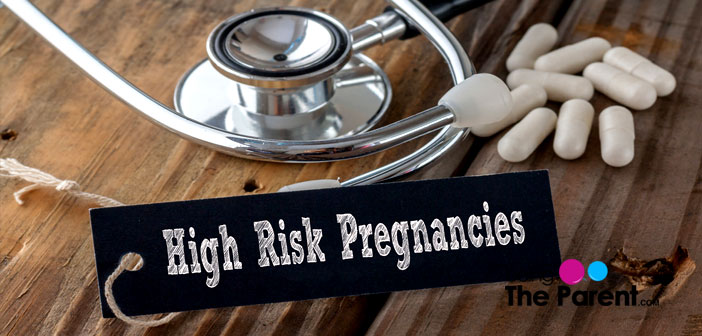More frequently than not, having a child is a natural process. Usually, the gestation period gets completed without any significant issues, and the mother will give birth to a sound, healthy child. A day or two later, she leaves the hospital and will start to enjoy motherhood. Be that as it may, not all expecting mothers can cut across the stage of pregnancy without difficulty. Some pregnant women will be unfortunate to sustain a high-risk pregnancy.

What Exactly Is A High-Risk Pregnancy?
A pregnancy is considered to come under the ‘high-risk category’ when it possesses potential complexities that could affect the mother, the child, or both. A high-risk pregnancy can create challenges (for mother or child or both)
Before delivery
In the course of delivery
After the delivery
Therefore, the mother and child should be monitored regularly to ward off undesirable and unexpected situations in the course of pregnancy and delivery.
What Are The Factors Which Make A Pregnancy ‘High-Risk’?
The factors that contribute to a high-risk pregnancy can be separated into four groups:
- Maternal age: One of the most widely recognized risk factors for a high-risk pregnancy is the age of the expecting mother. Both teen pregnancy and advanced maternal age pregnancy possess equal risks.
- Teen pregnancy: Both pregnant teens and their unborn babies possess distinctive medical risks. When a teenage girl gets pregnant-
- She is less likely to get enough prenatal care. This is mainly because she may be unaware of the pregnancy during the early months (which is the crucial period), or she may not be getting enough support from the home. Either way, inadequate medical attention during this early stage will affect the development of the baby and the health of the mother
- They are more prone to sexually transmitted diseases and infections, making the pregnancy more complicated
- She has an increased risk of getting high blood pressure and pre-eclampsia, a dangerous situation if left untreated
- Increased intake of medicines to control the above complications can trigger early labor
- Increased blood pressure, premature birth, giving birth to a baby with low birth weight, and postpartum depression is usually associated with teen pregnancies
- Overaged pregnancy: Getting pregnant around and above 35 years falls under high-risk pregnancy as they are at an increased risk of having:
- Excessive bleeding in the course of delivery
- Miscarriage
- Stillbirth
- Chronic diabetes and pre-eclampsia
- Prolonged labor or the labor that does not progress
- A child with birth defects
- A baby with Down’s syndrome and other chromosomal abnormalities
- Teen pregnancy: Both pregnant teens and their unborn babies possess distinctive medical risks. When a teenage girl gets pregnant-
- Existing health condition of the mother: If the mother has some medical conditions before getting pregnant, their chances to have a high-risk pregnancy increases. The preexisting health conditions of the mother that high-risk trigger pregnancy includes:
- Obesity: Being obese increases the mother’s chance of developing gestational diabetes. They are also more prone to pre-eclampsia and liver and kidney failure. In rare cases, stroke is also reported. Another complication is sleep apnea, a condition in which an individual stops breathing for a short period while sleeping. Sleep apnea is a disorder frequently associated with obesity. In the course of pregnancy, sleep apnea not only makes the mother more tired but also can set off high blood pressure, heart and lung disorder, etc. It can also cause macrosomia, a condition in which the baby is larger than normal. This increases the chances of C-section. Likewise, as the BMI increases, so will be chances of stillbirth
- Undergone treatment for infertility: A woman who has undergone infertility treatment and had medicines for it is found more inclined to take in pregnancy risks than the individuals who become pregnant without help
- Autoimmune disease: A woman who has autoimmune diseases like lupus can increase the risk of pregnancy. Certain medication that is used to handle this condition can also harm the unborn child
- PCOS: Not only the polycystic ovary syndrome is found to interfere with getting pregnant, but it also is found to make issues for staying pregnant. The rate of abortion is relatively very high in PCOS mothers
- Thyroid issues: Both overactive and under-active thyroids are equally harmful as they can create problems for the fetus resulting in birth defects and low birth weight
- The mother being HIV +ive: If the mother is diagnosed to have HIV (AIDS), the immune system of the mother will be immensely affected, and so will be the ability of her body to fight the infections. Also, the possibility of passing the HIV virus to the fetus during pregnancy or in the course of delivery cannot be ignored
- Underlying conditions: Underlying conditions of the mother such as high blood pressure, anemia, pre-existing issues with heart, lungs, and kidney, cancer, epilepsy, psychological issues, etc. can place the pregnancy under the high-risk category
- History of previous pregnancy issues: If the mother previously experienced three or more miscarriages, or has a history of stillbirth, pre-term labor, or any other serious pregnancy issues which can repeat during the subsequent pregnancies, the succeeding pregnancy is considered as high-risk
- Lifestyle choices of the mother: If the mother is in the habit of smoking cigarettes, drinking alcohol and using drugs, and once gets pregnant before dropping those lifestyle choices, pregnancy and delivery can be complicated
- Pregnancy complications: Even if the mother is physically fit when she gets pregnant, she can develop certain issues during pregnancy, which may adversely affect her health and her baby’s. Some of the most frequently reported pregnancy-related issues are:
- Gestational diabetes: It is a type of diabetes that appears once a woman is pregnant. If uncontrolled, it can create issues such as preterm delivery, stillbirth, and other health issues with the baby, high blood pressure, etc.
- Multiple pregnancies: Getting pregnant with more than one child increases the risk of premature labor. The babies will be of low birth weight. They are more vulnerable to breathing issues. The chances of health complications like anemia, birth defects, amniotic fluid abnormalities, cord entanglement, restricted fetal growth, postpartum hemorrhage, etc. can increase many folds in multiple pregnancies
- Amniotic fluid issues: Polyhydramnios (too much amniotic fluid) and oligohydramnios (very less amniotic fluid) can place the pregnancy under the high-risk category
- Complications of the placenta: Some of the placental issues that develop in the course of pregnancy placing it under high-risk are-
- Placental insufficiency: Failure of the placenta to provide enough nutrients for the unborn baby resulting in fetal growth restriction and low birth weight
- Placenta previa: Placenta previa is a condition in which placenta implants at the lower part of the uterus blocking the cervix
- Placental abruption: Placental abruption is a condition in which a part of the placenta separates from the uterine wall in the course of pregnancy. If the mother experienced placental abruption during the previous pregnancy, then the chances of the recurrence of the same in the subsequent pregnancy are increased by 25%
- Placenta accreta: This is a condition in which the placenta grows too deeply into the inner wall of the uterus causing excessive bleeding after childbirth, putting the life of the mother at the stake

What Should All Factors Be Considered While Selecting A Hospital And Doctor If My Pregnancy Is High-Risk?
If you possess a risk of pre-term labor, always choose a hospital that provides neonatal intensive care unit. Also, the hospital should be well-equipped, capable of handling any emergency. Depending on the severity of the risk factor you are experiencing, you should see a doctor who has extra training in high-risk pregnancies. They are called maternal-fetal medicine specialists (SMFM). Even if you are not able to find a doctor with that degree, don’t worry. You can always make a team of doctors discussing with the doctor you are regularly consulting. Make sure you’re your medical team should have the specialist (who is specialized in handling the particular issue you are experiencing), who can handle any unfortunate or unfavorable situations. And you should update all of them your conditions under weekly or once in two weeks’ duration. This will provide them enough knowledge of your developments.
What Are The Warning Signs To Seek Immediate Medical Attention During A High-Risk Pregnancy?
Seek immediate medical attention if you have any of the following symptoms:
- Vaginal bleeding: Even though spotting is common during pregnancy, in the case of a high-risk pregnancy, even spotting could be an indication of an upcoming issue. Therefore never ignore vaginal bleeding. If the bleeding is severe seek medical attention right away
- Fluid leaking: Once you notice a fluid leak, seek medical attention as soon as possible. Until you get medical attention, try to lay down on your back, in a position that your buttocks is higher than your head, to reduce the pressure on the cord
- Pain: If there is any pain in your belly, low back, or pelvic area, you should be watchful. Once the pain starts to increase and persist without any indication of turning down, it’s the time to seek medical attention. A severe headache is also not supposed to ignore as it is a significant sign of pre-eclampsia
- Fever
- Pain or burning sensation during urination
- Slowing down of fetal movement: You should be well-aware of the movement of the baby (if possible, it is better to maintain a chart when your pregnancy is tagged high-risk). Once you notice that the baby is moving less than normal (which is at least ten kicks per two hours) or not moving at all, it’s time to rush to the hospital
- Sudden swelling of the face, feet or hand or any problem with vision especially if diagnosed with pre-eclampsia
- Contractions: If you have had contractions (even mild tightening sensations) with or without pain like eight or more in one hour or four or more in twenty minutes and its frequency is not reducing even after you change position and drink water, it’s time for you to seek medical attention
- If you think that the umbilical cord is bulging out your vagina
Other than the above symptoms, any signs that bother you are significant enough to seek advice from your doctor, especially if you are undergoing a high-risk pregnancy.
What Steps Can I Take To Minimize My Risk And Promote A Healthy Pregnancy And Delivery?
There are certain steps that you should take to promote a healthy pregnancy and delivery, especially if you are categorized as high-risk.
- Never miss prenatal visits and tests once scheduled
- Never take any medications, even if it seems harmless to you, before asking your doctor
- Never forget to take medicines as instructed and prescribed by your doctor
- Eat a healthy diet and always make sure you are gaining weight wisely
- Always practice exercise (only if allowed) designed or approved by your doctor
- Stay away from people who have infectious diseases
- Avoid spending too much time in public area especially air-conditioned halls
- Try to stick on to homemade food and drinks
- Keep track of the movement of the baby
Even though “high-risk” sounds scary, there’s no reason to be frightened. The term high-risk pregnancy does not mean that you’re bound to have issues with your pregnancy. Many of the expecting mothers who have a high-risk pregnancy are found to have an issue-free pregnancy and deliver healthy babies. Having a high-risk pregnancy simply means that either due to a preexisting health condition or due to a condition that develops during pregnancy, you may have an increased chance of certain pregnancy complications. Because of this, some additional precautions like more prenatal visits, extra scans, additional treatments, and medications should be taken to ensure everything goes smoothly with your health and your baby’s health in the course of pregnancy and delivery.

